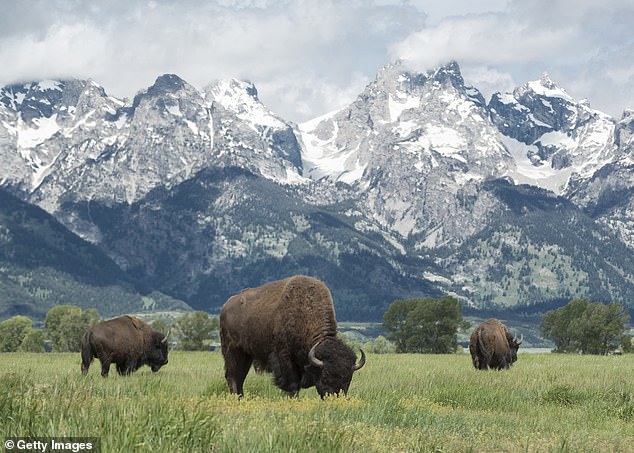For the first time in more than a century, something remarkable is happening across America’s great plains—bison are finding their way back home.
After decades of being penned in by fences, farmland, and modern infrastructure, these mighty animals are retracing ancient migration paths their ancestors once followed long before humans redrew the map of the land.
A Six-Year Journey into the Wild
Scientists have spent six years tracking this mysterious comeback story using GPS collars, satellite images, and field research.
What they found is nothing short of incredible: bison are naturally returning to their prehistoric corridors, guided by instincts that never faded despite generations of human interference.
Thanks to years of conservation work—restoring habitats and removing physical barriers—bison herds can now roam freely, following the seasonal cues of snow, vegetation, and water availability.
In a display of animal wisdom, older bison lead the way, showing younger ones the same routes passed down for thousands of years.
Nature’s Balance Begins to Return
By reclaiming these ancient routes, bison are doing more than rediscovering their past—they’re restoring balance to America’s ecosystems.
The study concluded that as these herds reestablish old patterns, the land itself is regaining resilience, rhythm, and health.
Today, there are roughly 5,000 bison in North America—a number that has stabilized since the mid-2010s.
This is an astonishing recovery considering that in 1902, only 23 were left alive.
Now, herds travel up to 1,000 miles each year, following a 50-mile migration corridor that pulses with new life.
Incredible Memory and Ecological Impact
Researchers also found that bison possess a phenomenal spatial memory, returning to the same nutrient-rich grazing spots once barriers are gone.
Bill Hamilton, the John T. Perry Jr. Professor of Research Science at Washington and Lee University, said the findings reveal something extraordinary about their role in the ecosystem.
“What we’re witnessing,” Hamilton explained, “is that as bison move across the landscape, they amplify the nutritional quality and capacity of Yellowstone.”
How Grazing Makes Grasslands Stronger
At first glance, the grazing patterns of these huge animals might seem destructive—but the opposite is true.
In Yellowstone’s river valleys, where bison graze during the warmer months, their feeding habits actually enhance soil fertility.
As they graze, bison kickstart the nitrogen cycle, encouraging microbes to break down dead plants and animals into nutrients like ammonium and nitrate that plants can easily absorb.
The result? The grass becomes not just as productive as ungrazed land, but up to 150 percent more nutritious—fueling healthier ecosystems and benefiting countless other herbivores.
Hamilton compared this transformation to the famous Serengeti, where the return of wildebeests once revitalized an entire ecosystem.
Tracking the Science Behind the Comeback
To understand these effects in detail, researchers conducted an intensive field study between 2015 and 2021.
They tracked everything—from soil chemistry and plant growth to nutrient cycling and microbial activity—using movable enclosures to compare grazed and ungrazed areas.
By combining satellite imagery with GPS data, scientists were able to map the bison’s full migratory impact across thousands of miles, painting a clear picture of how large, free-roaming herds shape entire landscapes.
The Power of Free-Roaming Herds
The findings highlight something many ecologists have long suspected: truly free-ranging bison are vital to the health of North America’s ecosystems.
When allowed to roam and graze naturally, these herds act as landscape engineers, creating rich habitats that benefit everything from birds to insects to predators.
The study suggests that restoring ancient migratory routes could be the key to revitalizing huge portions of the continent—reconnecting wildlife with the natural cycles that defined the land for millennia.
A Look Back at the Bison’s Epic History
Bison have been part of North America’s story for more than 10,000 years.
Before European settlers arrived, an estimated 30 to 60 million bison roamed freely across the continent—from Alaska and Canada all the way to Mexico and the eastern woodlands.
These massive herds shaped the prairies and grasslands, fertilized the soil, and supported an astonishing range of other wildlife.
For countless Native American tribes, bison were not just a food source—they were a cornerstone of culture, spirituality, and survival.
The Near-Extinction That Changed Everything
That balance was shattered in the 19th century when overhunting, commercial slaughter, and deliberate government policies nearly wiped bison out.
By the 1880s, fewer than 1,000 remained in the wild—a devastating collapse from the tens of millions that once thundered across the plains.
The loss wasn’t just ecological; it was deeply cultural. Native communities who relied on bison for food, clothing, and spiritual practices saw an entire way of life disappear with the herds.
The Long Road to Recovery
Conservation efforts began in the late 1800s, with small herds being protected in places like Yellowstone National Park and on private ranches.
These programs prevented total extinction but came with limitations—bison were fenced in, managed like livestock, and unable to migrate freely.
By the mid-20th century, the population began to climb again, but the herds were fragmented and confined.
It’s only in recent decades, with renewed efforts to restore open migration corridors, that bison have truly begun to roam as they once did—bringing life, balance, and hope back to the American wilderness.
Share on Facebook «||» Share on Twitter «||» Share on Reddit «||» Share on LinkedIn